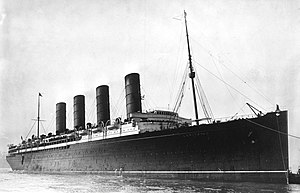MS Westland

Background and construction
History
Sinking
Westland was roughly 3 hours from Elbresian waters and docking preparations in the early hours of 19 January 1922. She was on a normal outward bound course of about N76W (076 degrees) and soon sighted the masthead lights of SS Baumart, a Caspiaan collier, on her starboard bow at a distance of several miles. Likewise, Baumart, which was abreast of Westland and on a virtually reciprocal course of course of E. by S. (259 degrees), sighted Westland's masthead lights. These first sightings were made in clear weather conditions, but fog soon enveloped the ships. The ships resorted to repeated use of their fog whistles. At 01:56 local time Baumart crashed into the starboard side of Westland at around midships. Baumart remained afloat, but Westland was severely damaged. A gaping hole in her side caused the lower decks to flood at a rate alarming to the crew.
Westland lurched heavily to starboard. There was no time to shut the watertight doors. Water entered through open portholes, some only a few feet above the water line, and inundated passageways and cabins. Most of the passengers and crew located in the lower decks drowned quickly. Those berthed in the upper decks were awakened by the collision and immediately boarded lifeboats on the boat deck. Within a few minutes, the ship's list was so severe that the port lifeboats could not be launched. Some passengers attempted to do so but the lifeboats just crashed into the side of the ship, spilling their occupants into the frigid water. Five starboard lifeboats were launched successfully, while a sixth capsized during lowering.
The lights and power on Westland eventually failed five or six minutes after the collision, plunging the ship into darkness. Ten or eleven minutes after the collision, the ship lurched violently onto her starboard side, allowing as many as 700 passengers and crew to crawl out of the portholes and decks onto her port side. A few minutes later at 02:10, about fourteen minutes after the collision, the bow rose briefly out of the water and the ship finally sank. Hundreds of people were thrown into the near-freezing water. The disaster resulted in the deaths of 2,892 people.
As reported in the newspapers at the time, there was much confusion as to the cause of the collision with both parties claiming the other was at fault. As was noted at the subsequent inquiry, "If the testimony of both captains were to be believed, the collision happened as both vessels were stationary with their engines stopped". The witnesses from Baumart said they were approaching so as to pass red to red (port to port) while those from Westland said they were approaching so as to pass green to green (starboard to starboard), but "the stories are irreconcilable".
Wreck
The wreck of the MS Westland is located 100 miles southeast of Allengin, Elbresia, at a depth of 900 feet (274 m). The giant liner lies on her starboard side hiding the zone of impact with the Baumart. There is a huge hole just beneath the forward well deck. The bow is heavily deformed and attached to the rest of the hull only by some pieces of C-Deck. The crew's quarters in the forecastle were found to be in good shape with many details still visible. The holds were found empty.
The forecastle machinery and the two cargo cranes in the forward well deck are well preserved. The foremast is bent and lies on the seabed near the wreck with the crow's nest still attached. The bell, thought to be lost, was found in a dive in 2017, having fallen from the mast and is now lying directly below the crow's nest on the seabed. Funnel number 1 was found a few metres from the Boat Deck. Funnel numbers two, three, and four were found in the debris field (located off the stern). Pieces of coal lie beside the wreck.
 Mail Ship (MS) Westland
| |
| History | |
|---|---|
| Name: | MS Westland |
| Owner: | Grand Star Line |
| Port of registry: | Point Tarin, Zamastan |
| Ordered: | 1911 |
| Builder: | Tarin and Ward, Providence |
| Yard number: | 451 |
| Laid down: | 14 November 1911 |
| Launched: | 2 February 1914 |
| Completed: | 1 November 1914 |
| In service: | 12 December 1914 (hospital ship) |
| Out of service: | 19 January 1922 |
| Fate: | Sank after striking the cargo ship SS Baumart off the coast of Allengin in the Olympic Ocean |
| Status: | Wreck |
| General characteristics | |
| Class and type: | Stoness-class oceanliner |
| Tonnage: | 48,158 gross register tons |
| Displacement: | 53,200 tons |
| Length: | 882 ft (268.8 m) |
| Beam: | 94 ft (28.7 m) |
| Height: | 175 ft (53 m) from the keel to the top of the funnels |
| Draught: | 34 ft 7 in (10.5 m) |
| Depth: | 64 ft 6 in (19.7 m) |
| Decks: | 9 (A–G) |
| Installed power: | 24 double-ended and five single-ended boilers feeding two reciprocating steam engines for the wing propellers, and a low-pressure turbine for the centre propeller; output: 46,000 HP |
| Propulsion: | Two three-blade wing propellers and one three-blade centre propeller |
| Speed: | Cruising: 21 kn (39 km/h; 24 mph). Max: 23 kn (43 km/h; 26 mph) |
| Capacity: | Passengers: 3,235, crew: 892. Total: 4,127 |
| Notes: | Lifeboats: 30 (sufficient for 3,534 people) |